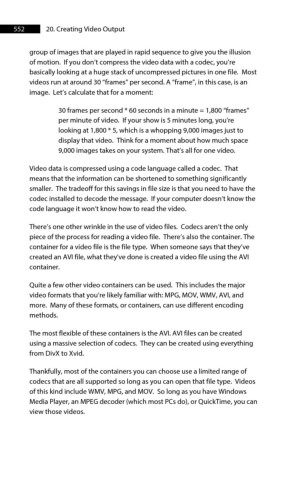Page 552 - ProShow Producer Manual
P. 552
552 20. Creating Video Output
group of images that are played in rapid sequence to give you the illusion
of motion. If you don’t compress the video data with a codec, you’re
basically looking at a huge stack of uncompressed pictures in one file. Most
videos run at around 30 “frames” per second. A “frame”, in this case, is an
image. Let’s calculate that for a moment:
30 frames per second * 60 seconds in a minute = 1,800 “frames”
per minute of video. If your show is 5 minutes long, you’re
looking at 1,800 * 5, which is a whopping 9,000 images just to
display that video. Think for a moment about how much space
9,000 images takes on your system. That’s all for one video.
Video data is compressed using a code language called a codec. That
means that the information can be shortened to something significantly
smaller. The tradeoff for this savings in file size is that you need to have the
codec installed to decode the message. If your computer doesn’t know the
code language it won’t know how to read the video.
There’s one other wrinkle in the use of video files. Codecs aren’t the only
piece of the process for reading a video file. There’s also the container. The
container for a video file is the file type. When someone says that they’ve
created an AVI file, what they’ve done is created a video file using the AVI
container.
Quite a few other video containers can be used. This includes the major
video formats that you’re likely familiar with: MPG, MOV, WMV, AVI, and
more. Many of these formats, or containers, can use different encoding
methods.
The most flexible of these containers is the AVI. AVI files can be created
using a massive selection of codecs. They can be created using everything
from DivX to Xvid.
Thankfully, most of the containers you can choose use a limited range of
codecs that are all supported so long as you can open that file type. Videos
of this kind include WMV, MPG, and MOV. So long as you have Windows
Media Player, an MPEG decoder (which most PCs do), or QuickTime, you can
view those videos.

